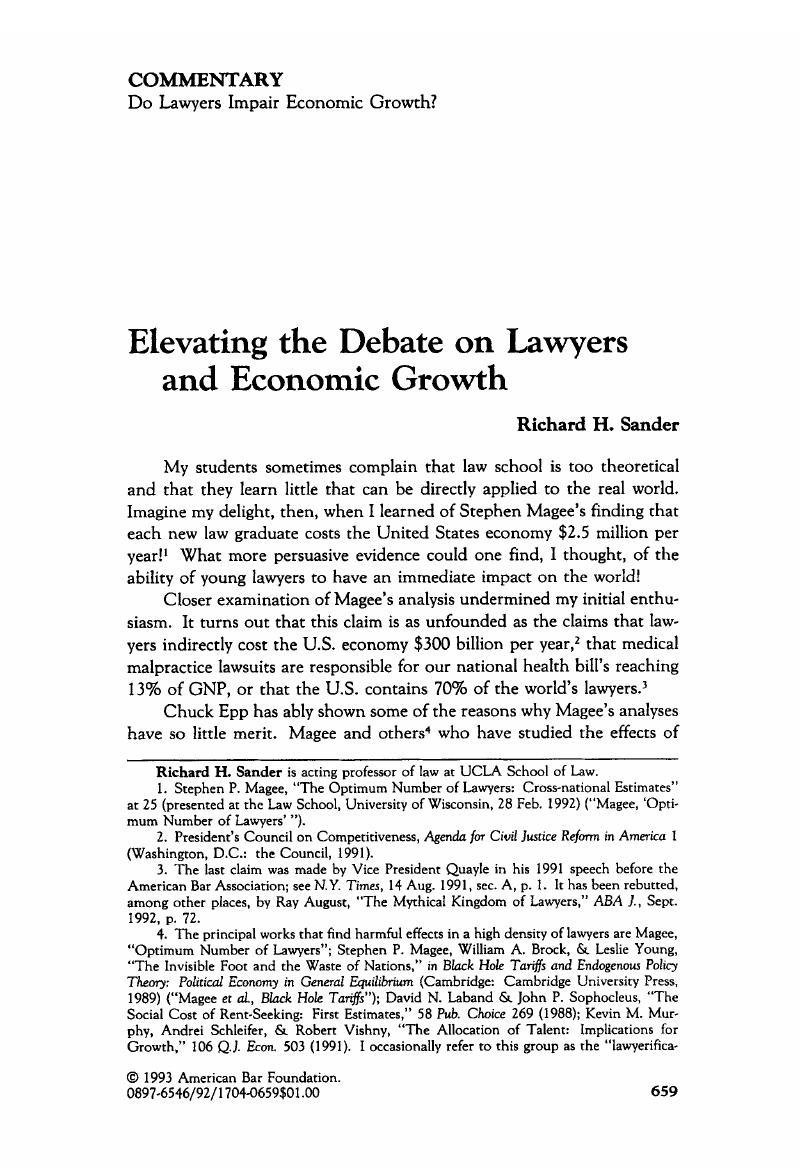Published online by Cambridge University Press: 27 December 2018

1 Magee, Stephen P., “The Optimum Number of Lawyers: Cross-national Estimates” at 25 (presented at the Law School, University of Wisconsin, 28 Feb. 1992) (“Magee, ‘Optimum Number of Lawyers’”).Google Scholar
2 President's Council on Competitiveness, Agenda for Civil Justice Reform in America I (Washington, D.C.: the Council, 1991).Google Scholar
3 The last claim was made by Vice President Quayle in his 1991 speech before the American Bar Association; see N.Y. Times, 14 Aug. 1991, sec. A, p. 1. It has been rebutted, among other places, by Ray August, “The Mythical Kingdom of Lawyers,”ABA J., Sept.1992, p. 72.Google Scholar
4 The principal works that find harmful effects in a high density of lawyers are Magee, “Optimum Number of Lawyers”; Magee, Stephen P., Brock, William A., & Leslie Young, “The Invisible Foot and the Waste of Nations,” in Black Hole Tariffs and Endogenous Policy Theory: Political Economy in General Equilibrium (Cambridge: Cambridge University Press, 1989) (“Magee et al., Black Hole Tariffs”); Laband, David N. & Sophocleus, John P., “The Social Cost of Rent-Seeking: First Estimates,” 58 Pub. Choice 269 (1988); Murphy, Kevin M., Andrei Schleifer, & Robert Vishny, “The Allocation of Talent: Implications for Growth,” 106 Q.J. Econ. 503 (1991). I occasionally refer to this group as the “lawyerification critics” but focus the most attention on Magee, who has made the most extreme claims and has garnered the most publicity.Google Scholar
5 In one sense, the authors did introduce a control variable; instead of lawyers perperson, they plotted lawyers per physician, purportedly in an attempt to control for the level of economic development in each country. Magee et al., Black Hole Tariffs. Google Scholar
6 Magee, “Optimum Number of Lawyers,” includes both correlations and regressions; Laband & Sophocleus, 58 Pub. Choice, relied in part on correlations; Murphy et al., 106 Q. J. Econ., adopt some very simple regressions.Google Scholar
7 Both Magee and Epp draw on a model developed by Robert Barro to analyze differences in economic growth rates (“Economic Growth in a Cross Section of Countries,” 106 Q.J. Eon. 407 (1991)). However, neither scholar incorporates all of Barro's variables, and Barro himself draws modest conclusions from his analysis and ties his models closely to theoretical comparisons.Google Scholar
8 The U.S. government counts, in each decennial census, the number of persons engaged in the practice of law; the American Bar Foundation and Martindale-Hubbell compile statistics on the number of persons certified to practice law. These measures arrive at different national totals, but each measure is methodologically consistent across states.Google Scholar
9 Epp refers to this limitation but suggests that the fact that Laband and Sophocleus secured significant results using this approach supports its adoption. However, since Epp demonstrates that their analysis is wrong, 1 am not persuaded by his attempt to resurrect their work to SUPPOK his own. Again, I think that the basic approach is as questionable as its particular incarnations.Google Scholar
10 I do not intend to imply that Epp is unaware of this issue; indeed, he mentions the usefulness of case studies in his conclusion. On the whole, however, I preferred the approach of Frank Cross, who, in a similar rebuttal of the “lawyerification” critics, used regressions to demonstrate the instability of Magee's results but focused his article on a discussion of the economic costs and benefits of lawyering. Cross, Frank B., “The First Thing We Do, Let's Kill All the Economists: An Empirical Evaluation of the Effect of Lawyers on the United States Economy and Political System,” 70 Tex. L Rev. 645 (1992).Google Scholar
11 Sander, Richard H. & E. Douglas Williams, “Why Are There So Many Lawyers? Perspectives on a Turbulent Market,” 14 Law & Soc. Inquiry 431, 433 (1989). Relative to the number of households, corporations, or government regulations, the volume of lawyers must have declined quite a bit.CrossRefGoogle Scholar
12 The 800,000 figure is based on a 12-month average from U.S. Department of Labor, Employment and Earnings, Jan.-Dec. 1991.Google Scholar
13 Epp makes a similar suggestion in sec. 1V.A of his article.Google Scholar
14 It seems quite conceivable that such a case could be made for, say, particular auto plants that car manufacturers have relocated from the United States to Mexico.Google Scholar
15 Cross, 70 Tex. L Rev. at 675–76. If the effect I describe is what Cross's analysis is picking up, finance would show up as more significant simply because it is a much larger sector, and productivity stagnation in that sector will therefore have more pronounced effects.Google Scholar